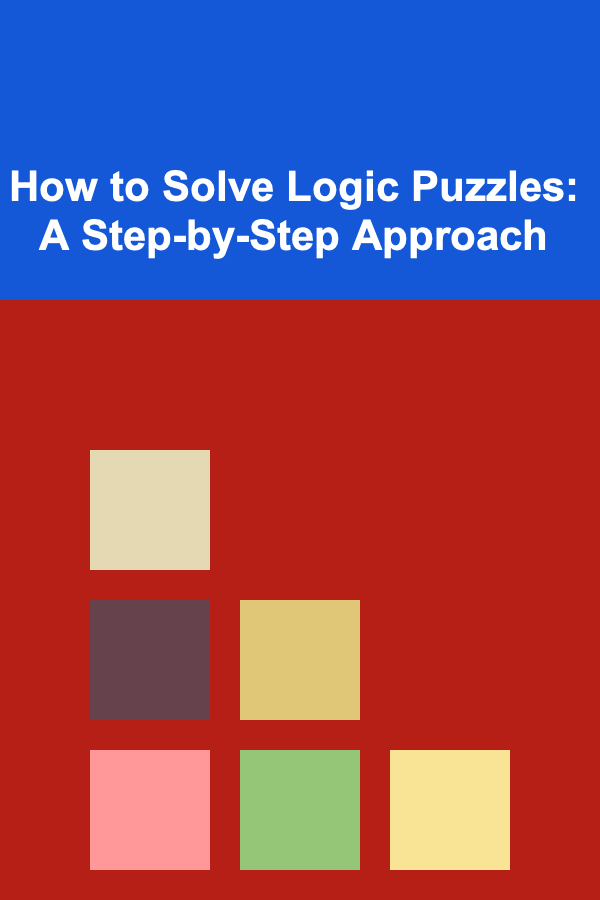
How to Solve Logic Puzzles: A Step-by-Step Approach
ebook include PDF & Audio bundle (Micro Guide)
$12.99$11.99
Limited Time Offer! Order within the next:

Logic puzzles are a captivating and intellectually stimulating way to engage with complex problems. These puzzles challenge your problem-solving skills and ability to think critically and analytically. Whether you're looking to improve your cognitive abilities or simply enjoy a fun and mentally rewarding pastime, solving logic puzzles can provide a sense of satisfaction and accomplishment. This guide will walk you through a systematic, step-by-step approach to solving logic puzzles, from basic strategies to more advanced techniques.
Understanding Logic Puzzles
Before diving into the steps for solving logic puzzles, it's important to understand what they are. Logic puzzles are problems that require reasoning and deduction to solve, often involving abstract scenarios or hypothetical situations. These puzzles can take many forms, including:
- Sudoku: A number-placement puzzle where you must fill a grid according to specific rules.
- Riddles: Short, often playful questions that require lateral thinking to solve.
- Grid-based puzzles: These puzzles involve a set of variables and conditions, requiring you to use logic to match them correctly.
- Word puzzles: Puzzles that involve patterns, associations, or wordplay, requiring you to think about language and its structure.
- Math puzzles: Problems where numbers and mathematical operations are used to arrive at a solution.
Regardless of the type, all logic puzzles share one key feature: they require you to think logically, not just rely on random guessing or intuition.
Preparing to Solve Logic Puzzles
The first step in solving any logic puzzle is to approach it with the right mindset and preparation. Here are a few essential tips to get started:
2.1. Read the Puzzle Carefully
The most important part of solving a logic puzzle is understanding the problem correctly. Read the puzzle several times to ensure you know exactly what is being asked. Look for important clues, constraints, or relationships between variables. In some puzzles, the wording may be tricky, so don't rush through the description---take your time to absorb all the information.
2.2. Organize Information
Many logic puzzles present a lot of information at once, which can be overwhelming. One way to keep track of the data is to organize it visually. Here are a few ways you can organize your information:
- Tables or grids: These are especially helpful for puzzles involving multiple variables or categories, such as a logic grid puzzle where you need to match items across different columns.
- Lists: If the puzzle involves options, conditions, or a set of constraints, lists can help you keep track of possibilities.
- Diagrams or drawings: For puzzles involving spatial reasoning, such as puzzles with shapes or directions, drawing diagrams can help clarify the relationships between different elements.
2.3. Identify Key Variables and Relationships
Every logic puzzle has key variables that need to be manipulated or matched in some way. Identifying these variables early on helps you focus on the most relevant information. Ask yourself:
- What are the variables involved (e.g., people, objects, places, times)?
- Are there any constraints or rules that govern how these variables interact?
- What relationships exist between the variables (e.g., "Person A is taller than Person B")?
2.4. Eliminate What Doesn't Work
In logic puzzles, often you'll need to use a process of elimination. As you identify possible solutions, you should also be mindful of what doesn't work. If something contradicts the rules or doesn't fit with the information you've gathered, eliminate it as a possibility. This process will gradually narrow down the number of viable solutions.
Step-by-Step Problem-Solving Process
Now that you're prepared, it's time to delve into the actual process of solving the puzzle. Here's a step-by-step guide to tackling most logic puzzles.
3.1. Break the Problem Down
Instead of trying to solve the entire puzzle at once, break it down into smaller, more manageable pieces. Start by identifying the most straightforward aspects of the puzzle. For example:
- In a grid puzzle, you might begin by filling in the easiest clues.
- In a word puzzle, you might focus on finding key words or patterns.
- In a math puzzle, start with any given numbers or operations and work from there.
By starting small, you make the puzzle feel less daunting, and you'll often discover new insights as you progress.
3.2. Work With What You Know
Logic puzzles often provide you with a few clear facts at the beginning---use these to your advantage. Work through the puzzle methodically, applying what you know. For instance, in a grid puzzle, begin by filling out the cells that are obviously determined. In a word puzzle, identify any direct clues that can help you start building a solution.
If you're dealing with a riddle, try to think about the problem from different perspectives. Consider all the possible interpretations of the question and look for hidden meanings.
3.3. Look for Patterns and Logical Relationships
A key part of solving logic puzzles is identifying patterns. Many puzzles rely on finding patterns in numbers, words, or shapes. Look for repeating elements or relationships that might emerge as you work through the puzzle.
For example, in a Sudoku puzzle, the pattern of numbers in each row, column, and grid must follow specific rules. In a logic grid puzzle, you may find that certain pieces of information can be ruled out, revealing a pattern that leads you toward a solution.
3.4. Make Logical Deductions
Once you've identified some facts or patterns, start making deductions. Logic puzzles are all about using deductive reasoning to draw conclusions. For instance, if you know that "Person A is taller than Person B" and "Person B is taller than Person C," you can deduce that "Person A is taller than Person C."
In more complex puzzles, you may need to use hypothetical reasoning. If a specific assumption leads to a contradiction or an impossible situation, then you can rule it out and try a different path. This process of testing different scenarios is a critical part of solving puzzles.
3.5. Check for Consistency
As you work through the puzzle, it's crucial to ensure that all your deductions are consistent with the puzzle's rules. Double-check your assumptions and make sure that no new information contradicts your previous steps. If you find a contradiction, retrace your steps and adjust your reasoning accordingly.
3.6. Solve Incrementally
If the puzzle allows for multiple steps or stages, solve it incrementally. Don't feel the need to complete the entire puzzle in one sitting. Break the puzzle into logical segments and solve one step at a time. This will make the problem more approachable and keep you from feeling overwhelmed.
3.7. Final Review
After reaching a solution, it's essential to review your work and confirm that your answer is correct. Reread the puzzle statement and check that every rule has been followed and every condition has been satisfied. Often, the final answer will be immediately obvious once you've solved the puzzle, but it's always wise to review it carefully to avoid missing something important.
Common Puzzle-Solving Strategies
While the steps outlined above provide a general approach to solving logic puzzles, there are several strategies that you can use to further enhance your ability to solve these puzzles. Here are some common techniques:
4.1. The Process of Elimination
In many logic puzzles, you can eliminate impossible options based on the information provided. As you narrow down your possibilities, you'll be left with fewer choices. The process of elimination can be particularly useful in grid puzzles, riddles, and word-based puzzles.
4.2. Working Backwards
Sometimes, working backwards can help you solve a puzzle. If you know the end result, you can trace your way back to the beginning, filling in the details as you go. This technique can be especially useful for puzzles that have multiple possible solutions.
4.3. Guessing and Checking
If all else fails, you may be able to use a guessing strategy. In this approach, you hypothesize a possible solution and then test it by checking if it fits the given conditions. If your guess doesn't work, discard it and try another. However, this technique should be used sparingly, as it can sometimes lead to unnecessary trial and error.
4.4. Logical Deduction
Logical deduction is the foundation of most puzzle-solving techniques. Whether you're dealing with numbers, words, or shapes, logical deduction allows you to systematically eliminate possibilities and narrow down the correct solution. The key is to ensure that every deduction you make is based on concrete, verified facts.
Practice and Patience
Like any skill, solving logic puzzles gets easier with practice. The more puzzles you tackle, the more adept you'll become at recognizing patterns, making deductions, and finding efficient solutions. Over time, your ability to think critically and solve complex problems will improve.
Additionally, don't be discouraged if a puzzle takes a long time to solve. Some puzzles are designed to be challenging, and it's perfectly normal to encounter obstacles. Be patient, keep practicing, and most importantly, enjoy the process of solving each puzzle.
In conclusion, solving logic puzzles requires a combination of careful reading, methodical organization, logical reasoning, and practice. By following the steps outlined above and using strategies such as the process of elimination, working backwards, and logical deduction, you can develop the skills necessary to tackle any logic puzzle that comes your way. With time, your puzzle-solving abilities will improve, and you'll gain a greater appreciation for the beauty of logic and reasoning.
Reading More From Our Other Websites
- [Gardening 101] Budget‑Friendly Homemade Sprays to Protect Your Organic Veggies
- [Organization Tip 101] How to Create a Seasonal Tool Checklist
- [Organization Tip 101] How to Establish a Routine for Seasonal Decluttering
- [Organization Tip 101] How to Keep Your Refrigerator Clutter-Free
- [Home Pet Care 101] How to Introduce New Foods to Your Pet's Diet
- [Home Lighting 101] How to Add a Touch of Luxury to Your Home with Lighting
- [Paragliding Tip 101] From Takeoff to Landing: Essential Data Points for Your Paragliding Logbook
- [Personal Care Tips 101] How to Choose Sunscreen for Combination Skin
- [Trail Running Tip 101] Off the Beaten Path: How Trail Running Transforms Your Outdoor Adventures
- [Small Business 101] Best Subscription Box Models for Niche Hobbyist Small Businesses

Becoming a Data Scientist: A Step-by-Step Guide to Building a Successful Career
Read More
How to Organize Travel Documents for Easy Access
Read More
How to Use a Whiteboard for Weekly Meal Planning
Read More
How to Master Rope Skills for Climbing
Read More
The Friendship Fix: Cultivating Meaningful Connections
Read MoreHow to Build a Vendor Payment Tracker in Google Sheets
Read MoreOther Products

Becoming a Data Scientist: A Step-by-Step Guide to Building a Successful Career
Read More
How to Organize Travel Documents for Easy Access
Read More
How to Use a Whiteboard for Weekly Meal Planning
Read More
How to Master Rope Skills for Climbing
Read More